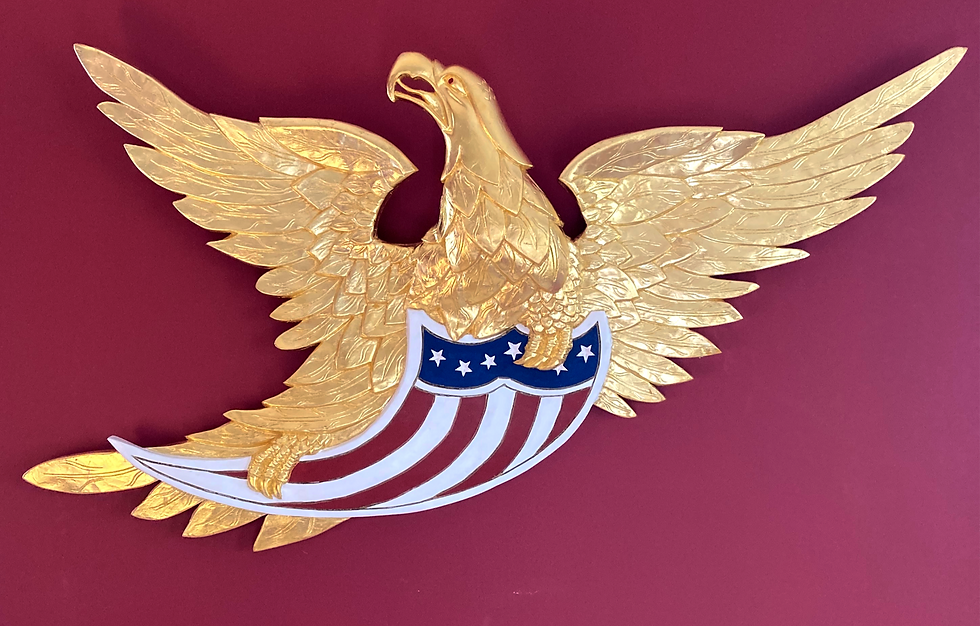Carving a Bellamy Eagle - Part I
- Wm. Francis Brown, Maine Coast Workshop
- Nov 22, 2020
- 4 min read
Updated: Jan 18, 2021

This blog series will outline the steps involved in carving one of my Bellamy eagles. I'll use different eagles to demonstrate the steps because I have not created a series of instructional photos yet with just one eagle. I will be teaching an eagle carving class at my Maine Coast Workshop in 2021 if folks express interest.
In this blog series we'll cover the roughing out process, clamping, tools, carving steps, making a banner, painting and lettering, gold leaf gilding, and mounting.
By way of intro, here's John Haley Bellamy, from Kittery, Maine. He is the entrepreneurial carver who made these eagles famous.....


We'll start this story at the end. Here are a few of my eagles for inspiration.....











The first step is obtaining some white pine or basswood (Linden) boards. I occasionally will use hardwoods for natural eagles: curly maple, cherry, or walnut, but must admit that these are kind of like chopping away at rock.
One or two inch thickness is enough depending on what kind of eagle you're carving. Anything thicker can be achieved by gluing up extra pieces of wood where needed.

A basic Bellamy starts with a board about 24 inches long by 1 inch thick. The head and the tops of two wings will be extra pieces of 1 inch thick wood glued on to achieve extra thickness. The board in the photo above would be OK for a 6 foot eagle.
Next, make a pattern and trace it on the board. I found that an old grade school overhead projector (Ebay $50) works well for enlarging and making patterns of any desired size. I copy the eagle outline on a transparency and then project it onto a big piece of luan onto paper taped to a wall, Get the size you want and then trace that on paper to make a pattern. I'll even do this process directly onto the carving board at times in order to speed things up.
Note below the extra piece for the head D and also for the two upper wing sections A & B (same pattern flipped and traced on to the extra pieces of wood).....

As mentioned, I'll project directly onto the board to speed things up, as seen below.....

Next cut the eagle outline shape on the bandsaw.....

Glue up the extra parts: head and two wing upper sections....

Then, I use Windsor chair tools to rough out the eagle. I use a scorp and drawknife here. It's a good workout. I have used power tools such as an angle grinder with various chainsaw attachments, etc. but that's loud, messy, and not any faster. You can do this with carving chisels but it goes a bit slower......

Flip the eagle over and round over the back of the wings........

I usually mount my big eagles in a vise which I bolted onto a very heavy iron girder. Big heavy swiveling vise from Harbour Freight for $50. BTW, this is my preferred vise for making windsor chair parts as well. I was never all that fond of using a shaving horse. I did smuggle a shaving horse into hotels a few times though when I was travelling with work so I could keep working on my chairs. Now that's dedication!

Chip and slice away til the front takes on the rough contours. Taper the wings down from the area close to the head all the way the tips. I do like to have the tips curve up a little at the ends to give a sense of movement. This requires removing more material form the back of the eagle at the wing ends so that the wing appears to curl up a little.
Here's an example of a deeply scooped wing. I do more of this than Bellamy...


NEXT: Stay tuned for Part II in which we will rough shape the eagle further and then start to set in the details.
If you want to learn these techniques and enjoy the camaraderie of fellow woodworking fanatics, consider a class in 2021 at the Maine Coast Workshop in Camden, Maine ("the prettiest village in Maine acc. to Down East Magazine and one of the top 10 vacation destinations acc. to Conde Nast). All skill levels accommodated.
Some of the upcoming instructors include:
Mary May - From Charleston, SC. Acanthus carving deep dive based on her new book
Marty Leehouts - chip carving master from MN
Ray Journigan - Make a Chippendale Phila. stool. Period Furniture Cartouche winner from VA beach. Lots of hand tools work, joinery and carving.
Alf Sharp - Another Cartouche winner, from TN. Make a Queen Anne armchair.
Alex Grabovetskiy - Russian born, from FL, won an award as "World's Best Carver". Classical carving class.
Matt Kenney - From MA, Author of the new book: "50 Boxes"; make a contemporary tea cabinet with his famous Komiko designs
Also, Windsor chairmaking, Ladderback chairmaking, Nantucket Basket class, Green Woodworking, Traditional Floor Cloth, Saw sharpening, Hand tool only classes ---> check out the website or stay tuned on this blog for updates.......










Comments